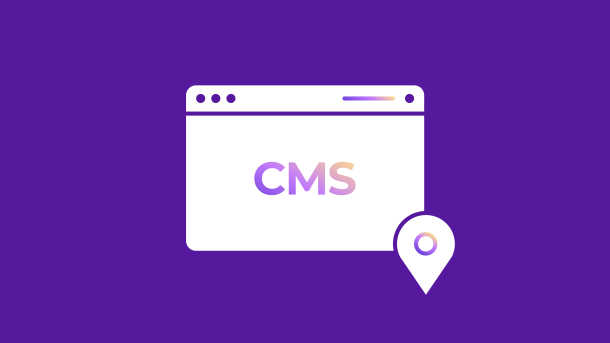Global companies must speak directly to each market to earn customers’ trust and business. Businesses must support every market they participate in with a library of translated content, graphics, resources, and marketing materials to reach local customers. Companies use a content management system (CMS) to store, organize, and publish this content online. If the content within a CMS doesn’t target each market it serves, most users won’t connect and become customers.
When we talk about CMS localization, we are talking about localizing the content held within the CMS, not translating and adapting the software itself.
Localizing a CMS content library is a large-scale project. While human translation offers the most accurate results, machine translation presents options for fast, high-quality localization at scale. This article shares the basics of CMS localization, including benefits, challenges, and best practices for achieving high-quality localization to scale.
The essentials of CMS localization
A CMS is a software application or tool that helps a company organize, modify, and deliver digital content on the web. It offers an intuitive user interface that lets non-technical individuals manage a website's content effectively and efficiently.
Typically, a CMS combines web-based publishing, format management, indexing, revision control, and a file search function. With a well-structured CMS, users can add or edit text, insert graphics and photos, create web pages, and change site navigation structures without extensive coding or web development knowledge. The main goal is to provide an easy-to-use tool to manage sophisticated websites without in-depth technical skills.
Some CMS tools offer plugin functionality to create multilingual content in common languages like English, Spanish, French, and Arabic. Headless CMS providers may also integrate with other microservices to provide additional offerings, such as translation services.
While these options may help companies with basic translations, they don’t replace a full localization strategy. Without one, translated content may miss vital cultural cues and introduce errors or offensive messaging in new markets.
Why every global business needs CMS localization
Customers want to shop local—even if “local” encompasses their home country as well as their hometown. For organizations to succeed in a global market, they must provide a content experience that looks and feels local and is easy for the end user to understand.
Creating a market-specific website isn’t enough. Customers want customized content, graphics, messaging, and resources. Localizing the content on your CMS platform is the best way to accomplish this level of market personalization.
The required time and financial investment to create localized content is well worth the cost. Well-crafted localized content helps businesses improve customer satisfaction, increase revenue in foreign markets, and ensure growth and market reach long-term. Over 80% of marketers report that localization has provided a moderately positive to extremely positive impact on their organizations’ revenue growth.
Localizing content for each market provides specific benefits to customers and financial impacts for brands, such as:
Faster market entry: Moving into a target market with ready-to-deploy localized content gives organizations an edge over competitors who don’t take the time to localize. Entering the market with well-translated and carefully localized content helps customers see the brand as a viable option, eases adoption, and starts sales off on the right foot.
Heightened cultural sensitivity: Each region or country has its own unique culture, traditions, and language nuances. Localization demonstrates respect and understanding for these differences and helps to prevent potential cultural misunderstandings or offensive messages. It also builds trust with the audience and fosters stronger connections and customer loyalty.
Improved user experience: Localization adapts content to make it more engaging and relevant for the target audience with native brand experiences. This adaptation could involve adjusting graphics, colors, formats, and currency units or even adopting local expressions and idioms. By providing a seamless user experience that feels native to each market, businesses can increase their site usability, which, in turn, can lead to higher conversion rates.
Better organic search results: Search algorithms succeed when they deliver the most desirable search results to users. Therefore, search engines place higher authority on optimized content that is localized for respective regions or countries. Localized content makes customers and prospects more likely to see your website first, which increases the chances of clickthrough and conversion.
Increased revenue: Improving localization in your CMS content helps to convert customers and drive sales. When customers feel comfortable with a brand’s content and message, it eases the customer journey and moves products. Investing in localization also delivers return on investment (ROI) in customer acquisition and increases revenue.
CMS localization is not just a nice-to-have. It facilitates a brand’s introduction to a new global audience and ensures its financial success when investing in new markets.
Five common challenges in CMS localization
Localization and translation are not synonyms. Translation presents a literal interpretation of words in a different language, but localization provides a more holistic approach that instead captures the message’s essence. It ensures that tone, meaning, cultural significance, and social expectations remain intact in the destination language.
Here are some of the most common challenges companies face when creating new CMS content for another market and language:
Language nuances: One of the biggest challenges in CMS localization is dealing with linguistic subtleties and cultural differences. Often, expressions and idioms don't translate directly from one language to another, which can lead to confusion or misinterpretation.
Formatting issues: Different languages use different scripts, punctuation, date formats, and numerical systems, all of which require accurate localization.
Resource constraints: Localization is a time-consuming, resource-intensive process. Small businesses may struggle to find the funds and manpower to translate and localize content into multiple languages.
Content updates: Changes to the original content must be present in each localized version. This can become a tedious task due to frequent updates or many different target languages.
Cultural sensitivity: Some images, symbols, or colors might have different connotations in other cultures. Brands must carefully consider these elements during the localization process to avoid any potential cultural misunderstandings or offenses.
CMS localization best practices
The way you approach localization goes a long way in determining the project’s success. When preparing CMS content for a new target market, use the following tips and best practices to ensure that the target audience embraces localized content:
Build a strategy
Before you begin, build a clear localization strategy with goals and metrics to measure progress. Your strategy should clarify the necessary tasks for successful localization, such as:
- Identifying the target market(s) that the localization project will address
- Establishing priority for content localization by asset type (such as website, landing pages, blogs, and sign-up forms)
- Documenting a project timeline and required deliverables
- Building (or hiring) a localization team to assist with development and review
- Outlining metrics for measuring project success
Conduct target market research
Research is the foundation for successful localization. It provides marketers with insights regarding the intended audience’s culture, language, behaviors, and preferences. This knowledge allows businesses to tailor their content effectively and enhance its relevance, appeal, and success in the targeted locale. Some key factors to consider when conducting target market research are demographics, cultural history, language variations, and consumer preferences.
Establish content priority
Localizing individual assets takes time, so it’s important to identify those that are most valuable and prioritize their conversion. This ensures faster time to market and more relevant messages.
Factors such as audience size, potential impact, and ROI may influence priority. For example, a landing page that receives high traffic from a specific country may be a top priority for localization in order to capture more leads and conversions from that market.
Document the project timeline and required deliverables
A clear project timeline helps to keep everyone who is involved in the localization process on track and accountable. The timeline should include deadlines for each stage of the project, from translation to review and finalization. It should also outline the review and approval workflow for asset development and finalization.
Collaborate with native speakers
Native speakers understand the nuances of their language and culture better than anyone else. Their input can significantly enhance your localized content’s translation quality. Collaborate with native speakers for translation, review, and quality control to ensure that your content is culturally appropriate and effective.
Leverage AI translation
While native speakers have the most refined grasp of cultural and linguistic nuance, a translation management platform with artificial intelligence (AI) offers impressive speed and cost tradeoffs while still delivering fidelity in content messaging.
AI allows users to power dynamic workflows and automation within their current translation management systems. Traditional translation processes and related workflows are slow and error-prone. Automated translation relies on AI to handle more basic and repetitive tasks, such as assigning jobs, reviewing and revising content, submitting content, or rejecting content altogether. Humans don’t have to do the grunt work, which saves you in labor costs.
Localize your CMS seamlessly with Smartling
A CMS may contain hundreds or thousands of assets, which makes localization projects particularly challenging. But AI-enhanced localization can deliver fast, accurate translations without losing your message’s context or the target language’s nuances.
Cutting-edge AI localization quickly delivers high-quality, localized assets for faster market entry and expanded reach, with the added benefit of access to talented native language–speaking translators.
Smartling integrates with many of the top-tier tools that brands use to drive their message forward, including Acquia, Builder.io, Contentful, Drupal, Optimizely, Sitecore, WordPress, and more.
To learn more about localization and how Smartling delivers high-quality, localized translations, check out our ebook, AI-Powered Localization: Achieving Quality, Cost, and Speed Objectives.






